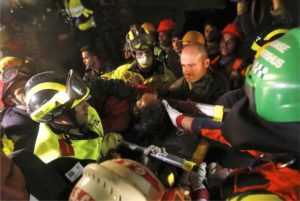 In the complex tapestry of disaster response, medical rescue teams form the most vital link between survival and tragedy. Disasters—ranging from natural catastrophes such as earthquakes, floods, and cyclones to man-made emergencies including industrial explosions, chemical spills, terror attacks, and pandemics—pose multifaceted challenges that stretch emergency health systems to their operational and ethical limits. As the world witnesses a rising trend in both the frequency and intensity of such events, the role of disaster medicine and public health preparedness has become more than just an auxiliary function—it is now an indispensable pillar of national resilience and global stability.
In the complex tapestry of disaster response, medical rescue teams form the most vital link between survival and tragedy. Disasters—ranging from natural catastrophes such as earthquakes, floods, and cyclones to man-made emergencies including industrial explosions, chemical spills, terror attacks, and pandemics—pose multifaceted challenges that stretch emergency health systems to their operational and ethical limits. As the world witnesses a rising trend in both the frequency and intensity of such events, the role of disaster medicine and public health preparedness has become more than just an auxiliary function—it is now an indispensable pillar of national resilience and global stability.
Medical rescue teams operate in highly volatile, time-sensitive environments where rapid decision-making, robust coordination, and a deep understanding of both clinical and logistical protocols are non-negotiable. The very nature of disasters often leads to partial or total breakdowns of critical infrastructure—hospitals may be non-functional, roads might be impassable, communication lines may be severed, and electric grids could be down. In such conditions, the first challenge medical teams face is access—getting to the affected areas safely and quickly. This problem becomes even more daunting in geographically isolated or politically unstable zones, where rescue missions are frequently impeded by aftershocks, fires, water contamination, or ongoing threats like civil unrest or secondary explosions.
 Once on the ground, the second layer of complexity unfolds. Mass casualties present a scenario where triage becomes the ethical backbone of the entire operation. In disaster medicine, the principle of “greatest good for the greatest number” often forces clinicians to make heart-wrenching decisions—prioritizing patients based on survivability rather than severity. This shift in medical ethics from individualized care to population-based strategies is a profound psychological burden for health professionals who are otherwise trained to do everything possible for every patient. The lack of appropriate diagnostic tools, advanced life-saving equipment, blood products, and even basic medications such as antibiotics and painkillers further compounds the clinical limitations.
Once on the ground, the second layer of complexity unfolds. Mass casualties present a scenario where triage becomes the ethical backbone of the entire operation. In disaster medicine, the principle of “greatest good for the greatest number” often forces clinicians to make heart-wrenching decisions—prioritizing patients based on survivability rather than severity. This shift in medical ethics from individualized care to population-based strategies is a profound psychological burden for health professionals who are otherwise trained to do everything possible for every patient. The lack of appropriate diagnostic tools, advanced life-saving equipment, blood products, and even basic medications such as antibiotics and painkillers further compounds the clinical limitations.
Compounding the chaos is the third challenge—coordination. Disaster zones often become hubs of inter-agency activity involving local government bodies, international aid organizations, the military, NGOs, and private sector responders. Without a unified command structure or clear communication protocols, efforts can become redundant or misdirected. Medical teams may find themselves operating in silos or unaware of the evolving threat matrix, leading to duplication of services in one zone and complete neglect in another. Public health coordination, including the setup of temporary sanitation systems, morgue operations, disease surveillance, and waste disposal, often gets delayed, heightening the risk of post-disaster epidemics like cholera, leptospirosis, and respiratory infections.
Another significant burden lies in the emotional and psychological strain faced by rescue personnel. The exposure to mass suffering, dismembered bodies, cries of the injured, and the emotional toll of separating family members or confirming deaths of children creates a deep psychological scar. Burnout, post-traumatic stress disorder (PTSD), and moral injury are common among healthcare responders. Despite their resilience, most medical rescue teams lack adequate psychological support systems to decompress post-mission. While physical injuries in disasters are well-documented, the silent epidemic of mental health deterioration among first responders is often overlooked in policy frameworks and disaster preparedness protocols.
Technology has made some inroads in addressing these challenges. Mobile field hospitals, drone-based aerial reconnaissance, telemedicine, satellite communication, and AI-based triage systems are slowly being integrated into advanced response teams. Yet, the widespread deployment of such innovations is hindered by funding constraints, interoperability issues, lack of trained personnel, and reluctance to shift from traditional methods. Furthermore, public health preparedness remains uneven across the globe. While countries like Japan, the U.S., and Australia have developed robust disaster medicine systems integrated with public health command centers and emergency stockpiles, many developing nations still lack basic emergency operation plans or have outdated disaster management frameworks.
A key insight from recent disasters—be it the COVID-19 pandemic, the Beirut port explosion, or floods in South Asia—is the critical need for community-based preparedness. Local medical teams, paramedics, and community health workers must be trained as the first line of defense. Building capacity at the grassroots level through simulation exercises, first-aid certification, mental health first responder training, and decentralized logistics hubs can dramatically reduce response times and improve outcomes. Similarly, the role of public awareness cannot be overstated. The public must be educated on basic response measures, such as how to administer CPR, how to safely evacuate buildings, and how to report injuries or missing persons effectively during a crisis.
From a policy and systems perspective, it is imperative to integrate disaster medicine into national healthcare curriculums, create specialized medical response battalions with multi-disciplinary expertise, and fund research in emergency medicine specific to large-scale crises. Multi-sector drills involving fire services, law enforcement, healthcare providers, and utility operators should be institutionalized. Digital dashboards for live casualty tracking, resource availability, and hospital bed mapping can support command-and-control centers in deploying teams where they are most needed.
To conclude, the challenges faced by medical rescue teams during disaster response are immense, spanning logistical, ethical, psychological, and infrastructural domains. Yet, each crisis also serves as a powerful learning platform—an opportunity to re-engineer our systems, empower our responders, and elevate the role of public health in crisis management. Investing in disaster medicine and public health preparedness is not merely about preparing for the worst; it is about honoring the human right to safety, care, and dignity in the darkest of times. For in every collapsed building, every flooded street, and every overwhelmed triage center, there exists the opportunity to reaffirm our collective commitment to saving lives and building a resilient future.























































